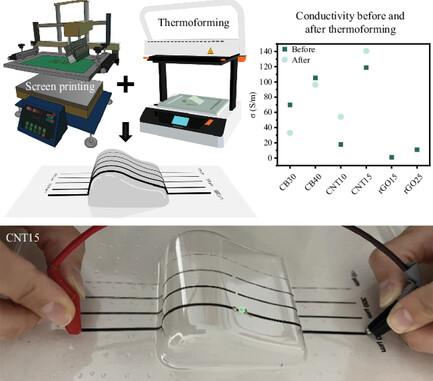含碳基填料的可拉伸导电油墨用于可成型印刷电子产品
IF 3.4
3区 材料科学
Q2 MATERIALS SCIENCE, MULTIDISCIPLINARY
引用次数: 0
摘要
随着全球电子垃圾的不断增加,社会要求和政府正在推动使用污染较少的材料和减少对环境影响的电子产品的发展。实现这一目标的方法之一是采用同时具有功能性和结构性的材料,减少材料的使用和部件的组装。此外,与传统电子器件相比,丝网印刷等印刷技术大大降低了成本和时间;结合使印刷电子器件符合三维形状的方法(如热成型),可以简单高效地获得非平面电子器件。本文报告了由苯乙烯-乙烯/丁烯-苯乙烯和不同纵横比的碳基材料制成的丝网印刷油墨,可用于保形电子器件。这些油墨以炭黑、碳纳米管和还原氧化石墨烯为导电填料,印刷在柔性基底上并热成型。碳黑和碳纳米管样品在加工后具有功能性,每种填料的最佳性能样品的导电率分别为 96 S m-1 和 141 S m-1。研究还对材料的流变、形态、热和电特性进行了表征。这项研究显示了填料的类型和长宽比对热成型前后印刷材料的形态和导电性能的影响。本文章由计算机程序翻译,如有差异,请以英文原文为准。

Stretchable Conductive Inks with Carbon‐Based Fillers for Conformable Printed Electronics
With the constant increase of electronic waste globally, society is demanding and governments are boosting the development of electronics with less pollutant materials and reduced environmental impact. One way to achieve this is to implement materials that are functional and structural at the same time, reducing material use and assembling parts. Further, printing techniques, such as screen printing, reduce considerably costs and time compared with conventional electronics; combined with methods to conform printed electronics to a 3D shape, such as thermoforming, allow to obtain nonplanar surface electronics simply and efficiently. Herein, screen‐printable inks made of styrene–ethylene/butylene–styrene and different aspect‐ratio carbon‐based materials for conformable electronics are reported. The inks are prepared with carbon black, carbon nanotubes, and reduced graphene oxide as conductive fillers, printed on a flexible substrate and thermoformed. Carbon black and carbon nanotube samples are functional after the process, with conductivities of 96 and 141 S m−1 for the best performing sample of each filler, respectively. Rheological, morphological, thermal, and electrical properties of the materials are also characterized. This study shows the influence of the filler's type and aspect ratio on the morphology and electrical conductivity of the printed materials before and after thermoforming.
求助全文
通过发布文献求助,成功后即可免费获取论文全文。
去求助
来源期刊

Advanced Engineering Materials
工程技术-材料科学:综合
CiteScore
5.70
自引率
5.60%
发文量
544
审稿时长
1.7 months
期刊介绍:
Advanced Engineering Materials is the membership journal of three leading European Materials Societies
- German Materials Society/DGM,
- French Materials Society/SF2M,
- Swiss Materials Federation/SVMT.
 求助内容:
求助内容: 应助结果提醒方式:
应助结果提醒方式:


